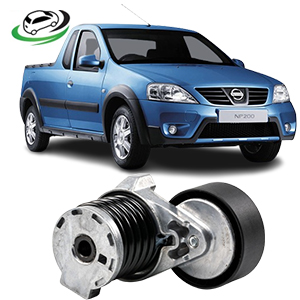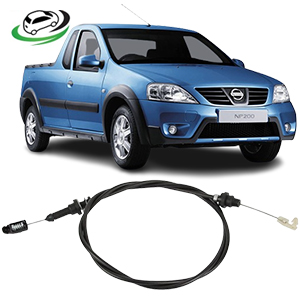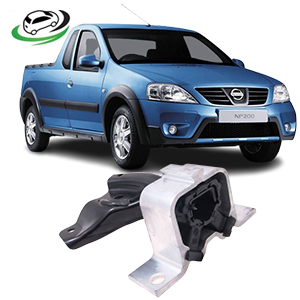Get Nissan Pick Up NP200 Front Engine Insulator Mounting Assy RH 11210-00Q0B
The front engine insulator mounting assembly, often referred to as the engine mount, is a critical component in automotive engineering. Its primary function is to secure the engine to the vehicle’s chassis while dampening vibrations and absorbing shocks. This assembly plays a significant role in ensuring that the vehicle operates smoothly, with minimal noise, vibration, and harshness (NVH) being transferred to the cabin. In this detailed 1000-word explanation, we will cover the structure, function, benefits, common issues, and maintenance of the front engine insulator mounting assembly.
1. Understanding the Front Engine Insulator Mounting Assembly
The engine insulator mounting assembly acts as the interface between the engine and the vehicle’s frame. It secures the engine in place while allowing it to move slightly in response to the engine’s torque and the road’s conditions. The front engine mount is typically located at the front of the engine bay, supporting the engine block and helping to manage the forces generated during acceleration, deceleration, and cornering.
2. Components of the Engine Mounting Assembly
The front engine insulator mounting assembly is composed of several key components, each contributing to its overall function:
- Rubber or Polyurethane Insulator: The main feature of the engine mount is a rubber or polyurethane block that dampens vibrations. The flexibility of this material allows the mount to absorb engine movement, preventing it from being transferred to the vehicle’s chassis and interior.
- Metal Brackets: These metal components are used to bolt the mount to both the engine and the chassis. They provide structural support and ensure that the engine remains securely attached to the frame.
- Hydraulic Fluid (in some mounts): Some advanced engine mounts incorporate hydraulic fluid within the rubber to further reduce vibrations. These mounts are referred to as hydraulic engine mounts or fluid-filled mounts, and they are often used in vehicles with high-power engines for improved NVH performance.
- Bolts and Fasteners: The assembly includes bolts and fasteners that connect the mount to the engine block and the chassis, ensuring it remains firmly in place even during high-stress driving conditions.
3. Function of the Front Engine Insulator Mounting Assembly
The primary function of the front engine insulator mounting assembly is to provide support to the engine and ensure that it stays aligned with the drivetrain and other components. However, it also performs several secondary functions that are crucial for the vehicle’s overall performance:
- Vibration Isolation: The engine generates significant vibrations due to the combustion process and the rotation of moving parts. The rubber insulator in the mount absorbs these vibrations, preventing them from being transmitted to the vehicle’s frame and passenger cabin. This results in a smoother and quieter ride.
- Shock Absorption: During acceleration, deceleration, or when driving on rough roads, the engine undergoes movement due to the forces acting on it. The front engine mount helps absorb these shocks, preventing the engine from excessive movement that could lead to damage.
- Engine Positioning: The mount ensures that the engine remains properly positioned in the engine bay. A correctly aligned engine is crucial for the smooth operation of the drivetrain, including the transmission and driveshaft. This helps maintain optimal performance and prevents undue strain on the vehicle’s components.
- Torque Management: When the engine produces torque (rotational force), especially during acceleration, it causes the engine to twist slightly. The engine mount is designed to control this motion, preventing the engine from moving excessively and maintaining the balance and stability of the vehicle.
4. Types of Engine Mounts
There are several types of engine mounts used in automotive applications, each with specific advantages depending on the vehicle and driving conditions:
- Rubber Engine Mounts: These are the most common and simplest type of engine mounts. They consist of a solid rubber block that absorbs vibrations. While effective, they can wear out over time, especially in high-performance vehicles.
- Hydraulic (Fluid-Filled) Engine Mounts: These mounts use a combination of rubber and hydraulic fluid to dampen vibrations more effectively. The fluid helps absorb a greater range of vibrations and shocks, making them ideal for vehicles with higher power engines or those focused on comfort.
- Active Engine Mounts: Found in some luxury or high-performance vehicles, active engine mounts use electronically controlled systems to adapt to different driving conditions. They can change their damping characteristics to minimize vibrations based on the engine’s load and speed.
- Polyurethane Engine Mounts: These mounts are stiffer than traditional rubber mounts and are often used in high-performance or racing vehicles. While they provide less vibration isolation than rubber or hydraulic mounts, they offer superior durability and control over engine movement.
5. Benefits of the Front Engine Insulator Mounting Assembly
A properly functioning engine insulator mount offers several significant benefits:
- Reduced Noise and Vibration: One of the key roles of the engine mount is to isolate the engine’s vibrations and noise from the rest of the vehicle. This results in a quieter, more comfortable driving experience, particularly at idle or during low-speed driving.
- Improved Ride Comfort: By absorbing engine shocks and vibrations, the mount improves ride comfort. Passengers experience fewer bumps and jolts caused by engine movement, especially when driving on rough roads.
- Enhanced Engine Stability: The mount helps keep the engine in place, ensuring that it doesn’t move excessively under acceleration or when cornering. This stability improves overall vehicle handling and performance.
- Protection of Other Components: A secure engine mount prevents excessive engine movement that could cause damage to other parts, such as the exhaust system, driveshaft, or transmission. It also helps maintain the proper alignment of these components, reducing wear and tear over time.
6. Common Problems with the Front Engine Mounting Assembly
Over time, the engine mount can wear out or become damaged due to constant exposure to heat, vibration, and engine forces. Some common issues associated with engine mounts include:
- Cracked or Worn Rubber: The rubber insulator in the mount can degrade over time due to heat, oil leaks, or exposure to the elements. Cracked or worn rubber will lose its ability to absorb vibrations, leading to increased noise and harshness in the vehicle.
- Fluid Leaks in Hydraulic Mounts: In hydraulic mounts, the fluid inside the mount can leak, reducing its ability to dampen vibrations. This can result in excessive engine movement and noticeable noise or vibrations inside the cabin.
- Loose or Broken Mounts: The metal brackets or bolts that secure the engine mount can become loose or break due to wear, corrosion, or excessive engine movement. This can lead to a clunking noise when accelerating or braking, and in extreme cases, the engine may shift out of place.
- Excessive Engine Movement: A worn or damaged engine mount can allow the engine to move more than it should. This can lead to poor alignment of the drivetrain components and cause issues such as misalignment of the transmission or driveshaft.
7. Symptoms of a Failing Engine Mount
A failing front engine mount can exhibit several noticeable symptoms, which may affect the vehicle’s performance and comfort:
- Increased Vibrations: One of the most common signs of a failing engine mount is increased vibrations inside the cabin. These vibrations are often more noticeable at idle or during acceleration.
- Clunking or Banging Noise: If the engine mount is loose or broken, you may hear a clunking or banging noise coming from the engine bay, particularly when accelerating, decelerating, or going over bumps.
- Engine Movement: If the engine mount is severely worn or broken, you may notice excessive engine movement when accelerating or decelerating. This movement can affect the vehicle’s handling and may cause damage to other components.
- Misalignment of Engine Components: A failing engine mount can cause misalignment of the engine, leading to issues such as transmission problems, misaligned driveshafts, or exhaust system damage.
8. Maintenance and Replacement of the Front Engine Mount
To ensure the longevity and performance of the engine mount, regular inspection and timely replacement are essential. Here are some maintenance tips:
- Inspect Regularly: During routine maintenance, inspect the engine mounts for signs of wear or damage, such as cracked rubber or loose bolts. Pay attention to any unusual vibrations or noises that could indicate a problem.
- Replace Worn Mounts: If the mount shows signs of wear or damage, it should be replaced promptly to prevent further issues. Delaying replacement can lead to increased engine movement and potential damage to other components.
- Choose the Right Replacement Mount: When replacing the engine mount, it’s important to use the correct type of mount for your vehicle. Some vehicles may benefit from upgraded mounts, such as hydraulic or polyurethane mounts, depending on the driving conditions and performance requirements.
9. Conclusion
The front engine insulator mounting assembly is a critical component in maintaining the smooth operation of the vehicle’s engine and drivetrain. By absorbing vibrations, reducing noise, and securing the engine in place, the mount plays a key role in improving ride comfort, handling, and overall vehicle performance. Regular inspection and timely replacement of worn mounts are essential to ensure that the vehicle continues to operate smoothly, efficiently, and safely. Understanding the function and importance of the engine mount can help vehicle owners maintain their vehicles and avoid potential issues down the road.
Follow us on Facebook for more parts.



